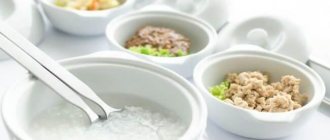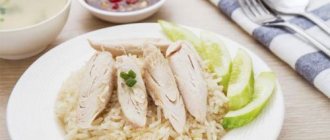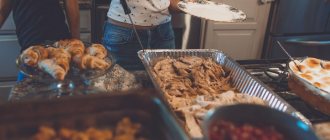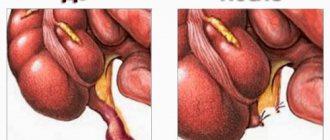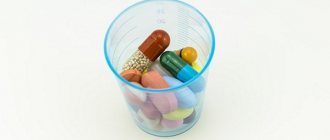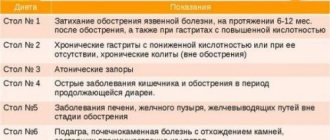If the patient has undergone surgery on the gastrointestinal tract, a long recovery period is required. At this time, the damaged mucous membrane and deeper tissues undergo a regeneration process. It is important to reduce the load on this area so that an inflammatory process does not develop. The surgeon warns that the patient will need to use the diet for a long time. Then recovery from abdominal injury will proceed without problems.
Principles of diet after surgery
Immediately after surgery on the first day, it is recommended to consume the following foods:
- drinking plenty of water, juices, decoctions;
- non-hard varieties of cereals;
- gradual introduction of vegetables on the 3rd day.
The listed products have a beneficial effect on the intestines, gradually restoring its function. Further additional rules are followed.
- The first day after surgery, a complete lack of food and water is recommended. The scar on the digestive organs must recover, heal, and heal. All nutrients that the body requires are administered intravenously.
- In the next 2 weeks, only liquid food is used, which is gentle on the gastrointestinal tract.
- It is prohibited to fry, bake, or smoke food. It can be boiled or steamed. The resulting dishes are ground in a blender and consumed in the form of porridge.
- The optimal duration of the diet is 1 month. But upon recommendation, it can be extended.
- It is permissible to eat food of plant and animal origin. It is forbidden to consume harmful foods and fast food.
- Splitting meals. They take all the food that the patient should eat in a day. It is divided into 6 doses, each of which should be no more than 100 ml. Approximately 3 hours should pass between meals.
- Temperature. It is forbidden to eat cold or hot food. It should be warm.
- Fermented milk products are gradually introduced.
If you use the above rules, postoperative complications should not arise.
General rules
The most common reasons for bowel resection are:
- Thrombosis of mesenteric vessels.
- Intestinal obstruction . The operation is performed in the least traumatic way - only the altered intestine is resected, volvulus and intussusception are eliminated.
- Malignant or benign tumors.
- Abdominal injuries.
- Crohn's disease . Resection of a significant portion of the small intestine is performed in the presence of massive bleeding or small intestinal fistulas . However, resection is not a cure for this disease and the relapse rate without drug treatment is quite high.
- Nonspecific ulcerative colitis . They resort to subtotal resection of the colon with the formation of ileosigmostoma (after 10-12 months, reconstructive operations are performed). colectomy is also performed .
The extent of resection determines the severity of the patient’s condition and disturbances in nutritional status. Can be carried out:
- Partial resection - the length of the removed area is up to 100 cm.
- Extensive - more than 100 cm is removed.
- Short intestine - the preserved part of the small intestine is less than 100 cm. “Short small intestine syndrome” develops.
After resection, the ability of the digestive canal to perform functions is impaired to varying degrees. With extensive resections of the small intestine, absorption is impaired. The small intestine takes an active part in digestion: food gruel is exposed to bile, intestinal juice, and pancreatic enzymes, under the influence of which food is broken down into individual components. This is where nutrients are absorbed.
After major operations, various types of metabolism are disrupted, including the exchange of bile acids , which take part in the digestion of fats. During operations on the colon, the microbiota and immune changes occur.
Extensive resection of the jejunum (part of the small intestine) is accompanied by malabsorption with the development of malabsorption syndrome . Diarrhea is typical , and sometimes bloating occurs.
During resection of the jejunum, hypersecretion of hydrochloric acid , and an increased load with it aggravates diarrhea. Patients experience weight loss, adipose tissue decreases, and protein loss occurs. In the early stages, appropriate nutrition and medication can eliminate diarrhea.
Complete resection of the ileum (part of the small intestine) causes serious problems. It normally absorbs 80% of the bile acids produced by the liver, and the rest in the colon is deconjugated by the intestinal flora. Deconjugated products are partially absorbed in the colon, and some are converted into secondary bile acids, which, when absorbed, enter the liver for repeated cycles (5-10 cycles per day). This ensures savings in bile acids, the daily synthesis of which the liver is not able to provide.
The cause of diarrhea in patients with removal of this part of the intestine is loss of bile acids, as well as unabsorbed fatty acids. The severity of diarrhea depends on the length of the remaining intestine (stump). With its length from 50 to 200 cm, it adapts to new anatomical conditions, but the adaptation time is different and depends on the volume of the removed part and the reserves of the remaining part. of iron deficiency anemia may appear . Deficiencies of proteins, potassium and magnesium also develop. Requirements for the protein component and energy should be increased by 1.5 times.
With subtotal resection of the small intestine (jejunum and ileum are removed), the condition of patients is more severe. There are no functional intestinal reserves. Due to malabsorption of nutrients, patients lose significant weight and their fat mass sharply decreases, they are bothered by severe weakness, and have a deficiency of potassium, calcium, magnesium, zinc, chlorides, trace elements and vitamins .
Severe anemia is noted due to impaired absorption of iron, folic acid and vitamin B12 and impaired protein absorption. Patients develop protein-energy malnutrition , a deficiency of omega-3 fatty acids , and show signs of cachexia . Patients need correction of metabolic disorders in a hospital setting, since weight loss can be 5% per year. In the absence of infusion-nutritional correction, the prognosis is unfavorable.
With small-colic resections, osmotic diarrhea . Colon bacteria ferment lactose and produce lactic acid, which worsens diarrhea. Translocation of the intestinal microflora occurs and its activity changes, which leads to a deficiency of microelements, vitamins, magnesium, and a decrease in the immune response. The body's need for protein is within normal normal limits, but the energy supply should be increased by 1.5 times.
Considering these disorders, the diet after intestinal surgery should be as gentle as possible on the mucous membrane of the digestive tract with a gradual expansion of the load. After the operation, the patient receives parenteral nutrition in the form of intravenous solutions for a week. From the fifth day, oral administration of adapted mixtures is possible. By the end of the second week, the patient can be transferred to Diet No. 0A , which includes liquid and jelly-like dishes:
- low-fat meat broth;
- berry jelly;
- rice water with cream;
- compote;
- rosehip decoction;
- fruit (diluted) juices.
After three days, you can introduce a soft-boiled egg. Meals are organized 7-8 times a day. After three days, it is possible to switch to Table No. 1A (surgical), including:
- liquid pureed porridge (rice, oatmeal, buckwheat) in meat broth, water with milk;
- slimy soups;
- low-fat meat broth with the addition of semolina;
- scrambled eggs;
- protein steam omelette;
- soufflé/puree from low-fat meat or fish;
- jellies, mousses;
- cream (no more than 100 g).
The next stage of nutrition is Table No. 1B (surgical). It serves to transition to physiologically nutritious nutrition and contains:
- puree soups;
- steam dishes from pureed boiled meat/chicken/fish;
- pureed fresh cottage cheese with the addition of cream or milk;
- fermented milk drinks;
- pureed milk porridge;
- baked apples;
- vegetable and fruit purees;
- white crackers;
- tea with milk.
Further nutrition and the possibility of expanding the diet are agreed with the doctor and depend on the scope of the operation. The patient may be recommended a table of therapeutic Diet No. 1, which is physiologically complete with a limitation of gastric secretion pathogens and irritants, or taking into account functional disorders (diarrhea, malabsorption) - Diet No. 4B (mashed), which the patient must follow for up to two months. This diet provides moderate intestinal sparing and includes:
- fractional meals;
- boiled and steam methods of its preparation;
- pureed and puréed vegetables, grains and meats;
- stimulants of gastric secretion (radish, radish, celery, turnip, sorrel, mushrooms), solid and roughage foods are not allowed;
- products that cause fermentation are excluded (grapes, sweet fruits, legumes, brown bread, sweets, bananas, baked goods, whole milk, cabbage, cucumbers, carbonated drinks).
More details about the features of Table No. 4B , indicated for patients with diarrhea, will be discussed below.
For patients with a resected colon, microbiocenosis disorders are more typical. The patient is bothered by bloating and discomfort in the intestines, but the digestion and absorption of food is not impaired. The functional reserve of the remaining intestine is sufficient to ensure vital activity or may be reduced during the first 6 months after surgery.
This is a common type of intervention performed for colon cancer , polyposis , ulcerative colitis complicated by bleeding, diverticulosis , Crohn's disease and intestinal obstruction . With left-sided hemicolectomy (removal of the left part of the large intestine), more pronounced dysbiosis is observed than with right-sided hemicolectomy. Among the consequences of colon resections, one can note a deficiency of magnesium, vitamin K and B vitamins.
Prohibited types of products
If the patient has had surgery, be sure to include the following types of foods that lead to increased stress on the digestive tract:
- allergenic foods - citrus fruits, nuts;
- foods that cause increased gas formation - legumes, mushrooms (a postoperative scar may rupture, which will lead to peritonitis);
- cauliflower, white cabbage;
- sour apples, grapes, pears;
- bakery products, products with yeast;
- soda, alcohol.
It is prohibited to consume smoked, fried, salted foods. You cannot use any spices or pepper for dishes.
A week after the start of rehabilitation, doctors allow you to drink coffee. It has a beneficial effect on the gastrointestinal tract. But he does this only with the permission of the attending physician.
After the diet, the patient’s stool formation mechanism should gradually normalize. Additionally, a proper diet reduces the load on the gastrointestinal tract. The patient's recovery will be faster and the rehabilitation period will be shortened.
When should you contact your healthcare provider?
Call your healthcare provider if you experience any of the following:
- diarrhea and fever 100.4°F (38°C) or higher;
- diarrhea and vomiting;
- diarrhea that does not stop for more than 24 hours;
- diarrhea, foul-smelling discharge, or increased leakage from the stoma.
If you have questions about your diet, call 212-639-7312 to speak with an outpatient dietitian.
You can contact a branch employee from Monday to Friday from 9:00 to 17:00. to come back to the beginning
Allowed foods after surgery
Food that does not cause inflammation and does not overload the digestive tract is acceptable:
- different types of cereals;
- fruits, vegetables, eggs;
- fermented milk products;
- lean meats;
- decoctions, compotes, water, tea, fresh juices;
- crackers.
The listed products must be combined and consumed in turn so that the beneficial substances enter the digestive tract in full.
Drawing up a menu after surgery to eliminate intestinal obstruction
Intestinal obstruction can occur due to many reasons. Once they have been eliminated, it is necessary to reduce the load on the gastrointestinal tract. To do this, use a special diet developed by a doctor. But first it is necessary to carry out complete and high-quality treatment in order to eliminate the factors that impede the passage of the food bolus and feces.
The following products must be consumed after surgery:
- diuretic decoction, for example, from rose hips;
- unrefined vegetable oil;
- prunes, raisins;
- fermented milk products.
Products must be eaten immediately after preparation. But they must cool to room temperature.
After completing the operation, it is recommended to adhere to the following rules:
- Do not use the microwave to heat food;
- It is prohibited to use products containing preservatives, flavors, carcinogens, dyes and other harmful substances;
- significantly reduce the amount of salt to a minimum;
- maintain water balance, drinking at least 2 liters of water per day;
- solid food is ground into porridge.
The doctor warns that after waking up from surgery, drinking water and food is prohibited for the first day. All nutrients are administered intravenously to prevent stress on the gastrointestinal tract. Next, adhere to the basics of a diet that has a beneficial effect on the intestines. All food should be easily digestible and not accumulate in the intestines. It is important to divide food into 6 meals so that the minimum level of food is placed in the gastrointestinal tract.
Basic diet after tumor resection
To prevent postoperative complications, you need to create a high-quality diet. The intestines and other organs of the gastrointestinal tract should not be overloaded. There is no specially designed diet; the attending physician prepares it independently for each patient, based on the characteristics of his body and state of health. The following recommendations are made:
- mandatory inclusion of fruits and vegetables;
- exclusion of any junk food;
- steaming or boiling; it is unacceptable to fry foods;
- thorough, prolonged chewing of food;
- prohibition on chewing food on the go;
- splitting the daily diet into 6 meals with reduced portions;
- inclusion of foods containing large amounts of microelements, vitamins, minerals and antioxidants.
If surgery has been performed, the absorption of nutrients from foods becomes more difficult. It is necessary to normalize this process using the right diet. Therefore, it is important to use easily digestible food that does not irritate the mucous membrane.
If the patient continues to have constipation after surgery, be sure to consult a doctor. He will change your diet and may prescribe medications.
To reduce the risk of developing constipation, it is imperative to maintain a water regime. Drink at least 2 liters of water per day. Additionally, they consume a large amount of fiber, which stimulates intestinal motility. It is important to exclude rice and pasta, they can lead to constipation.
Reviews and results
In some cases, recovery of bowel function after surgery may take several months. This nutrition helps to more quickly adapt to changed anatomical conditions. Moderate sparing, preparing dishes by boiling, eating in small portions and excluding foods that provoke deterioration are necessary points for restoring the function of the organ.
Only patience and careful implementation of all nutritional recommendations will ultimately help restore health. This is reported in patient reviews. A balanced diet allows you to follow the diet for a long time.
- “... I have been suffering from nonspecific ulcerative colitis for 15 years. Frequent exacerbations and unsuccessful treatment for many years, the appearance of non-healing fistulas led to me being offered surgery. As a result, a meter of the small intestine and part of the large intestine were removed. Nutrition began with a pureed and gentle diet, but it accompanies therapy and does not lead to a cure. Only after four months did she begin to selectively and very carefully expand her diet. Now I already know what I can eat and what remains forbidden forever. The diet is healthy and I tolerate it well. We can say that I adhere to it constantly with minor deviations. There is no diarrhea, and I am not losing weight. I allow myself sweets, soft sweet fruits”;
- “... Crohn's disease often worsened (pain, diarrhea, blood in the stool) and treatment was ineffective. In addition, a narrowing of the intestines appeared. After 10 years of suffering and hospitalizations 2 times a year, the doctor suggested removing the altered section of the intestine and said that with subsequent proper treatment, exacerbations may not occur at all. The operation was performed laparoscopically, but a section of the intestine had to be removed because balloon expansion failed to achieve results. Now the only way out is constant proper nutrition and treatment. The diet helps me: pain and diarrhea are reduced, activity is restored, and appetite improves. Cooking in a double boiler does not take much time (I cook vegetables, meat and porridge in a bag all at once). I have forever excluded smoked, fried, spicy and unhealthy foods”;
- “... For my son, due to Crohn’s disease, a section of 15 cm of the ileum and 15 cm of the cecum was removed using the laparoscopic method. There was stenosis of the ileum - this was manifested by severe pain after any food, severe weakness and shortness of breath. At that time, he could eat thin porridge for baby food and drank Modulen. The operation was successful, removal of 30 cm had almost no effect on intestinal function, and the son recovered relatively quickly. Of course, for a period of 3-4 months I had to strictly follow a diet and learn to eat again. It was also important not to give up treatment. Humira and Azathioprine were prescribed. Today, my son has recovered, plays sports, and life has improved. I teach the whole family to eat healthy.”
Approximate diet for 1 week
Immediately after the operation, the patient is consulted by a nutritionist. He should make a list of foods that he needs to eat daily. After discharge from the hospital, the diet is continued. This helps restore the digestive tract further. At home, you can use the diet indicated in the table.
| Day | Menu |
| Mon | Breakfast - buckwheat porridge, dried fruit compote. Lunch - steamed omelette, glass of water. Lunch - chicken broth, green tea. Snack: berries. Dinner - steamed fish fillet, compote. Late dinner - ryazhenka |
| W | Breakfast - oatmeal, black tea. Lunch - rye bread crackers, berry juice. Lunch - vegetable soup, dried fruit compote. Snack - biscuits, tea. Dinner - cottage cheese casserole with a little honey and compote. Late dinner - kefir |
| Wed | Breakfast - pearl barley porridge, dried fruit compote. Lunch - banana. Lunch - fish soup, black tea. Afternoon snack - boiled egg, compote. Dinner - cutlet, mashed potatoes. Late dinner - low-fat yogurt |
| Thu | Breakfast - buckwheat porridge, green tea. Lunch - egg soufflé. Lunch - lean borscht, a slice of bread, tea. Snack: fruit. Dinner - steamed fish, vegetables. Late dinner - ryazhenka |
| Fri | Breakfast - oatmeal, green tea. Lunch - fruits, compote. Lunch - crackers. Snack: fruit jelly. Dinner - steamed meatballs, mashed potatoes. Late dinner - kefir |
| Sat | Breakfast - steamed omelette, crackers, compote. Lunch - fresh fruit. Lunch - vegetable soup, compote. Snack - biscuits, tea. Dinner - cutlet, mashed potatoes. Late dinner - kefir |
| Sun | Breakfast - rice porridge, rosehip infusion. Lunch - boiled egg, compote. Lunch - chicken soup, vegetables, green tea. Afternoon snack - low-fat cottage cheese, green tea. Dinner - vegetable stew, compote. Late dinner - jelly |
The daily diet may vary slightly depending on the patient’s taste preferences.
Vegetables
You may have trouble digesting raw vegetables after surgery. Start by eating small amounts (½ cup) of well-cooked vegetables from the “Typically Well Digested” column in the table below. Chew them thoroughly. If you can tolerate cooked vegetables well, you can try raw vegetables in small quantities.
Avoid vegetables that cause gas or discomfort.
| Usually well absorbed | May cause gas or discomfort |
|
|
to come back to the beginning
Dietary requirements
After surgery, it is important to follow a certain diet to normalize digestive function. There are the following recommendations that the patient must follow even at home:
- if crackers are included in the diet, they are made from wheat bread;
- it is allowed to cook porridge, but based on water or skim milk;
- meat and fish are finely chopped or ground, these particles should be small;
- eggs must be heat treated, the yolk should not be runny;
- Fermented milk products should contain a minimum amount of fat.
A few weeks after the procedure, new products are gradually added. But they are still subjected to adequate heat treatment. For example, stewed, boiled, steamed. If the diet is composed correctly, rehabilitation will take place without problems for the digestive tract. Recovery will take a minimum amount of time. It is especially important to use all the recommendations in the first few days after surgery, otherwise complications will arise. If you feel worse, have prolonged constipation, or have abdominal pain, contact your doctor again.
Fortified milk recipe
- Mix 1 quart (4 cups (1 L)) milk with 1⅓ cup (320 ml) instant milk powder (usually 1 packet).
- You can use any milk (such as whole, 2 percent, 1 percent, skim or Lactaid®).
- Mix the ingredients thoroughly.
- Store in the refrigerator.
This will make about 4 servings of fortified milk.
Nutrition Facts per 8 oz (240 ml) serving when mixed with:
- whole milk: 230 calories, 16 grams protein;
- 2 percent milk: 200 calories, 16 grams protein;
- 1 percent milk: 180 calories, 16 grams protein;
- skim milk: 160 calories, 16 grams protein.
to come back to the beginning
